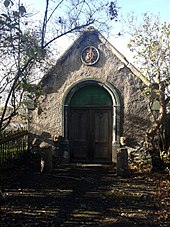Radewell / Osendorf
|
Radewell / Osendorf district of Halle (Saale) |
|
|---|---|
| Coordinates | 51 ° 25 '22 " N , 12 ° 0' 8" E |
| Residents | 1682 (December 31, 2016) |
| Post Code | 06132 |
| prefix | 0345 |
| Transport links | |
| bus | 24, 724 |
Radewell / Osendorf is a district of the Ammendorf district north of the White Elster in the southern district of Halle (Saale) in Saxony-Anhalt . It includes the villages Osendorf, Burg and Radewell, which are incorporated into Halle. The oldest surviving structure is the Church of St. Wenceslas in Radewell.
history
Radewell and Osendorf belonged to the Giebichenstein office in the hall circle of the ore monastery of Magdeburg . In 1680 they came with the Saalkreis to the Duchy of Magdeburg under Brandenburg-Prussian rule.
With the Peace of Tilsit , Radewell and Osendorf were incorporated into the Kingdom of Westphalia in 1807 and assigned to the Halle district in the Saale department. The places came to the canton of Glaucha . After Napoleon's defeat and the end of the Kingdom of Westphalia, Napoleon's allied opponents liberated the Saalkreis in early October 1813. During the political reorganization after the Congress of Vienna in 1815, Radewell and Osendorf were attached to the Merseburg administrative district of the Prussian province of Saxony in 1816 and assigned to the Saalkreis.
In 1920 Radewell and Osendorf were incorporated into Ammendorf and with this on July 1, 1950 to Halle (Saale). The lignite mines in the vicinity of Radewell and Osendorf were part of the Ammendorfer Revier .
Attractions
Tomb of the Austrian Sinto Josef Weinlich, known as Nauni, who died in Osendorf in 1915 , on the site of the former Osendorfer cemetery. It is a small, listed chapel called the Gypsy mausoleum.
The Evangelical Church of St. Wenceslas in Radewell goes back to the 12th century. It has Romanesque and Gothic elements and an altar from 1710.
As a post-mining landscape , the Osendorfer See , on which there is a training and regatta course for canoeing , emerged from a remaining open pit .
The Saale-Elster valley bridge is a railway bridge on the new Erfurt – Leipzig / Halle line , which spans the White Elster in the Saale-Elster-Aue south of Osendorf about 5 km before it flows into the Saale. It was built between 2006 and 2013 and, with a total length of 8,614 m, is the longest bridge structure in Germany and the longest long-distance railway bridge in Europe . As a special feature, there is a branching on the bridge construction.
Web links
- City of Halle (Saale): Radewell / Osendorf district (with map). Retrieved July 27, 2020.
- Halle (Saale) in figures 2016 (PDF) accessed on December 29, 2017
Individual evidence
- ^ City of Halle: Overview of the city district
- ↑ Mention of the place in the book "Geography for all Stands", p. 125f.
- ^ Description of the Saale Department
- ^ The hall circle in the municipality register 1900
- ↑ Halle (Saale) and its districts on gov.genealogy.net
- ↑ Heimat-Jahrbuch Saalkreis 1999, Volume 5, pp. 81–85.
- ↑ Britta Schulze-Thulin: Hiking Guide for Central Germany , Halle (Saale) 2005, p. 140.





